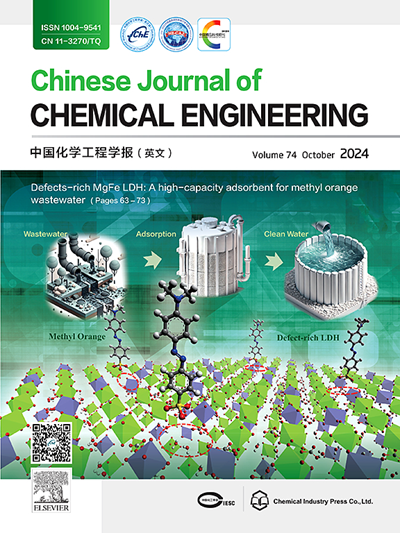Adsorption process for purifying vanadium from chromium-contaminated leaching solutions using zirconium-based adsorbents
IF 3.7
3区 工程技术
Q2 ENGINEERING, CHEMICAL
引用次数: 0
Abstract
With the development of vanadium redox flow battery technology, the demand for pure vanadium is rapidly increasing. The separation of vanadium from vanadium–chromium leaching solutions are critical step in the production of purity-vanadium. This study presents an innovative adsorption process that utilizes amorphous ZrO2 (AZrO) for the selective separation of V(V) and Cr(VI). In this process, a high adsorption capacity for V(V) at 64.5 mg·g−1 was achieved, while the capacity for Cr(VI) is relatively low at 24.1 mg·g−1, demonstrating good separation performance. This is mainly caused by the large specific surface area and mesoporous structure, which are favorable for molecular diffusion and mass transfer. The kinetic analysis shows that the adsorption process follows pseudo-second-order kinetic process with chemisorption being the rate-controlling process. AZrO showed excellent separation performance in mixed solutions over a wide range of concentrations. After five cycles, AZrO retained over 73% of its capacity, indicating good stability. In mixed solutions containing up to 40 g·L−1 of V(V) and 3 g·L−1 of Cr(VI), the innovative adsorption process successfully achieved effective separation and purification. By an adsorption–desorption process using 0.1 mol·L−1 NaOH, a 99.02% V(V)-rich solution was obtained from a high concentration sodium vanadium slag leaching solution, demonstrating its effectiveness for practical industrial applications.

锆基吸附剂对铬污染浸出液中钒的吸附工艺研究
随着钒氧化还原液流电池技术的发展,对纯钒的需求量迅速增加。钒铬浸出液中钒的分离是生产纯钒的关键步骤。本研究提出了一种利用无定形ZrO2 (AZrO)选择性分离V(V)和Cr(VI)的创新吸附工艺。该工艺对V(V)的吸附量较高,为64.5 mg·g−1,而对Cr(VI)的吸附量较低,为24.1 mg·g−1,具有较好的分离效果。这主要是由于大的比表面积和介孔结构有利于分子扩散和传质。动力学分析表明,吸附过程遵循准二级动力学过程,化学吸附是控制速率的过程。在较宽的浓度范围内,AZrO在混合溶液中表现出优异的分离性能。经过5次循环后,AZrO保持了超过73%的容量,表明了良好的稳定性。在含有高达40 g·L−1 V(V)和3 g·L−1 Cr(VI)的混合溶液中,创新的吸附过程成功地实现了有效的分离和净化。采用0.1 mol·L−1 NaOH吸附-解吸工艺,从高浓度钒钠渣浸出液中获得了富V(V) 99.02%的溶液,证明了该工艺在实际工业应用中的有效性。
本文章由计算机程序翻译,如有差异,请以英文原文为准。
求助全文
约1分钟内获得全文
求助全文
来源期刊

Chinese Journal of Chemical Engineering
工程技术-工程:化工
CiteScore
6.60
自引率
5.30%
发文量
4309
审稿时长
31 days
期刊介绍:
The Chinese Journal of Chemical Engineering (Monthly, started in 1982) is the official journal of the Chemical Industry and Engineering Society of China and published by the Chemical Industry Press Co. Ltd. The aim of the journal is to develop the international exchange of scientific and technical information in the field of chemical engineering. It publishes original research papers that cover the major advancements and achievements in chemical engineering in China as well as some articles from overseas contributors.
The topics of journal include chemical engineering, chemical technology, biochemical engineering, energy and environmental engineering and other relevant fields. Papers are published on the basis of their relevance to theoretical research, practical application or potential uses in the industry as Research Papers, Communications, Reviews and Perspectives. Prominent domestic and overseas chemical experts and scholars have been invited to form an International Advisory Board and the Editorial Committee. It enjoys recognition among Chinese academia and industry as a reliable source of information of what is going on in chemical engineering research, both domestic and abroad.
 求助内容:
求助内容: 应助结果提醒方式:
应助结果提醒方式:


